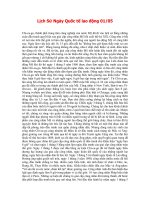05 exceptions 01 Slide Java
Bạn đang xem bản rút gọn của tài liệu. Xem và tải ngay bản đầy đủ của tài liệu tại đây (304.74 KB, 31 trang )
16/1
Exceptions
Exceptions
Reading: Savitch, Chapter 8
16/2
Objectives
Objectives
To learn what an exception is.
To learn how to handle an exception.
16/3
What is an Exception?
What is an Exception?
An exception is an object that describes an
unexpected situation.
Definition: An exception is an event that
occurs during the execution of a program
that disrupts the normal flow of
instructions.
16/4
Example
int a = 4, b = 4;
int [ ] intAy = new int[4];
intAy[0] = a/(a - b);
//this will generate and throw an ArithmeticException
//object
for(int k = 1; k <= 4; k++)
{ intAy[k] = a * k; }
//this will generate and throw an
//ArrayIndexOutOfBoundsException object
16/5
Exceptions are thrown by a program or the
run time environment, and may be caught
and handled by another part of the program.
A program can therefore be separated into a
normal execution flow and an exception
execution flow.
16/6
Exception Classes in API
Exception Classes in API
Many exceptions have been defined in
java.lang.
java.lang.Throwable is the top of the
hierarchy of exception and error classes.
16/7
Throwable has two direct subclasses
-
java.lang.Exception
-
java.lang.Error
All exception classes are subclasses of
java.lang.Exception.
16/8
Example
java.io.EOFException
java.io.FileNotFoundException
java.lang.NumberFormatException
etc.
16/9
Object
Throwable
LinkageError
ThreadDeath
VirtualMachineError
AWError
RunTimeException
ArithmeticException
IndexOutOfBoundsException
NullPointerException
and several more
IllegalAccessException
NoSuchMethodException
ClassNotFoundException
and several more
Error
Exception
Figure 8.1
Part of the
Error
and
Exception
class hierarchy
16/10
Checked and Unchecked
Checked and Unchecked
Exceptions
Exceptions
Exceptions are divided into two categories
– checked and unchecked.
All subclasses of RuntimeException
represent unchecked exceptions. All other
exceptions are checked exceptions.
16/11
A checked exception must be handled in the
program. While handling unchecked
exception is optional.
16/12
A programmer can also define their own
exception classes (will be discussed later).
A program can deal with an exception in
one of three ways:
- ignore it (for unchecked exceptions only)
- handle it where it occurs.
- handle it in an another place in the
program (propagate it).
16/13
Ignore an Exception
Ignore an Exception
If an unchecked exception is ignored by the
program, the program execution will be
terminated and an appropriate message will
be displayed.
16/14
Example
//IgnoreEx.java
public class IgnoreEx {
public static void main(String [ ] args) {
int a = 4, b = 4;
int intAy;
System.out.println(“The start of IgnoreEx”);
intAy = a/(a - b);
System.out.println(“The end of IgnoreEx”);
}
}
16/15
The program execution will be
% java IgnoreEx
The start of IgnoreEx
Exception in thread "main"
java.lang.ArithmeticException: / by zero
at IgnoreEx.main(IgnoreEx.java:7)
16/16
In the circumstance where a checked
exception cannot be ignored, then a throws
statement can be used to throw the
exception.
The syntax of the throws statement is
throws exceptionObject;
16/17
Example
public static void main(String [ ] args)
throws IOException, FileNotFoundException {
}
16/18
Handle an Exception
Handle an Exception
Whenever It is Thrown
Whenever It is Thrown
The try…catch…finally statement can be
used to handle exceptions whenever they
are thrown.
The syntax of the statement is as follows.
16/19
try {
statementTry; //exceptions may be thrown from here
}
catch(Exception1 e1) {
statementException1; //handle the exception e1
}
catch(Exception2 e2) {
statementException2; //handle the exception e2
}
… …
finally {
statementFinally; //the code will always be executed
}
16/20
statementTry is the code segment which
may throw exceptions.
Each catch clause has an associated
exception type.
Once an exception is thrown, it will be
compared with each catch clause. The
statement in the first matched catch clause
will be fired.
16/21
The statementFinally will always be
executed.
- If no exception is generated,
statementFinally is executed after
statementTry in the try block.
- If an exception is generated,
statementFinally is executed after the
statement in the appropriate catch clause is
completed.
16/22
catch and finally clauses are optional .
16/23
Example
//CatchEx.java
import java.io.*;
public class CatchEx {
public static void main(String [ ] args) {
System.out.println("The start of CatchEx");
private final int N = 3;
private int intAy[ ] = new int [N];
16/24
try {
BufferedReader stdin = new BufferedReader
(new InputStreamReader (System.in));
for (int i = 0; i <= N; i++) {
System.out.println ("Input an integer:");
intAy[i] = Integer.parseInt (stdin.readLine());
}
}
catch(IOException e1){
System.out.println("IOException: " +
e1.getMessage());
}
16/25
catch(NumberFormatException e2){
System.out.println("NumberFormatException: " +
e2.getMessage());
}
catch(ArrayIndexOutOfBoundsException e3){
System.out.println("ArrayIndexOutOfBounds: " +
e3.getMessage());
}









